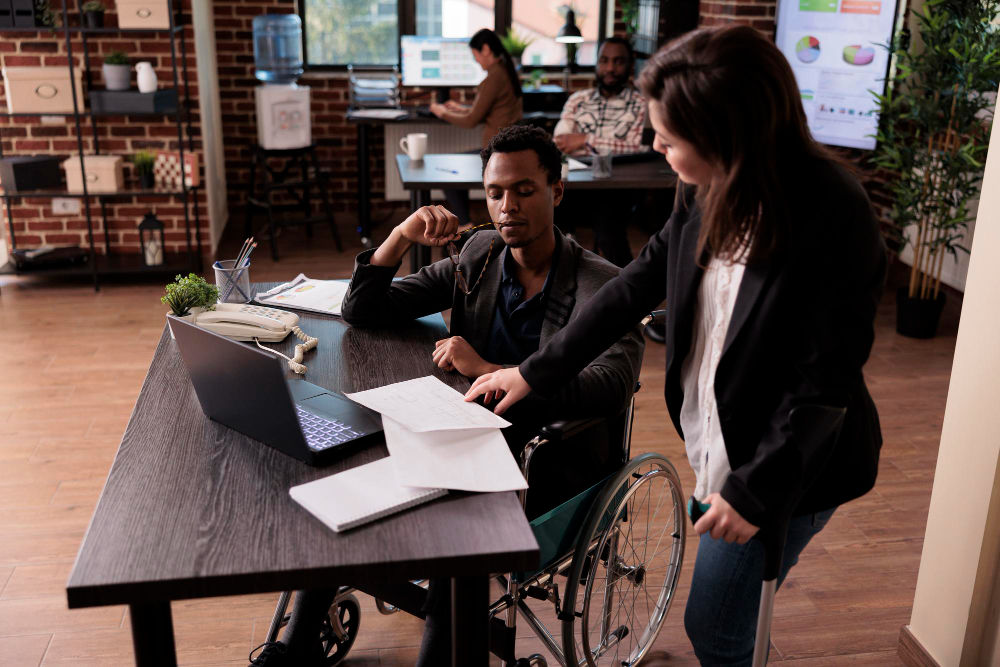Accessible E-Learning Development: Essential Practices for Success
 vinay Bommena
vinay Bommena
As the demand for eLearning grows, ensuring that online educational content is accessible to all learners has become a key priority. Accessible eLearning development refers to the process of creating digital learning experiences that can be used by individuals with diverse abilities, including those with disabilities. This approach not only broadens the reach of educational materials but also ensures compliance with various accessibility laws and standards. In this article, we will explore the fundamentals of accessible eLearning development and offer insights into how to create inclusive, user-friendly courses for all learners.

1. Why Is Accessible E-Learning Important?
The importance of accessible eLearning development goes beyond legal compliance — it’s about providing equal learning opportunities to everyone. Whether it’s a student with a visual impairment or a professional with limited mobility, accessible eLearning ensures that no one is excluded from valuable educational content.
Legal Compliance: Many countries have strict regulations, such as the Americans with Disabilities Act (ADA) in the U.S., that require digital content to be accessible to individuals with disabilities. Failure to comply with these standards can lead to legal ramifications.
Broader Reach: Accessible eLearning opens up your content to a wider audience, including individuals with disabilities who would otherwise be unable to engage with traditional online courses.
Improved Learning Experience: Accessibility features such as clear navigation, transcripts, captions, and alternative text for images benefit all learners, not just those with disabilities. These features can enhance comprehension and user experience.
2. Key Principles of Accessible E-Learning Development
To ensure that eLearning content is accessible, it’s important to follow the four principles of the Web Content Accessibility Guidelines (WCAG), which serve as a foundation for creating inclusive digital content. These principles are:
Perceivable: Information and user interface components must be presented in a way that can be perceived by all learners. This includes providing alternatives for non-text content, such as captions for videos and transcripts for audio content.
Operable: All users should be able to navigate and interact with the content. This includes ensuring that eLearning modules can be accessed using a keyboard (rather than a mouse) and that there are no time limits that restrict interaction.
Understandable: The content must be clear and easy to understand. This includes using simple language, providing instructions, and offering text alternatives to complex visuals or diagrams.
Robust: The eLearning content should be compatible with a variety of assistive technologies, such as screen readers or voice recognition software, ensuring that it can be used by a wide range of learners.
3. Common Accessibility Challenges in E-Learning
Despite the benefits, many organizations struggle with accessibility issues in their eLearning courses. Some common challenges include:
Visual Elements Without Alternatives: Many eLearning modules rely heavily on visuals such as images, graphs, and videos, but fail to provide text alternatives for learners with visual impairments. Without descriptions or captions, these learners may miss out on important information.
Interactive Elements Not Keyboard Accessible: Many interactive elements like drag-and-drop quizzes or clickable animations are designed for mouse users, which creates barriers for learners who use keyboards or assistive devices like screen readers.
Complex Navigation Structures: Complicated layouts or inconsistent navigation can confuse learners, especially those with cognitive disabilities. A cluttered interface can also make it harder for individuals with visual impairments to use the course effectively.
Lack of Audio Alternatives: Learners with hearing impairments may face difficulties when video and audio elements don’t include captions or transcripts. This limits their ability to fully engage with multimedia content.

4. Best Practices for Accessible E-Learning Development
Overcoming accessibility challenges requires thoughtful planning and the application of best practices. Here are some effective strategies for ensuring your eLearning content is accessible:
Provide Text Alternatives for Non-Text Content: Use alt text to describe images, charts, and graphs for learners using screen readers. Videos should be accompanied by closed captions and transcripts to ensure that all learners can access the content.
Ensure Keyboard Accessibility: Make sure that learners can navigate the course using a keyboard. Test your content by using only keyboard controls, ensuring that learners can access all interactive elements without relying on a mouse.
Use Simple and Clear Language: Avoid jargon, complex sentence structures, and overly technical terms. Clear, concise language benefits all learners and makes your content more accessible to those with cognitive disabilities.
Structure Content with Headings and Lists: Organize your content with a logical structure using headings, bullet points, and numbered lists. This not only improves readability but also helps screen readers convey information more effectively.
Test with Assistive Technologies: Regularly test your eLearning content with various assistive technologies like screen readers, voice recognition software, and keyboard-only navigation. This ensures that your course works for all users.
Offer Multiple Ways to Interact with Content: Provide alternative means for learners to interact with quizzes, assignments, or activities. For example, allow learners to type answers instead of dragging and dropping items if necessary.
Use High Contrast and Legible Fonts: Ensure that your text is legible by using high contrast between text and background colors. Additionally, use sans-serif fonts and provide options to adjust font size for those with visual impairments.
5. Tools and Resources for Accessible E-Learning Development
Creating accessible eLearning content can be made easier with the right tools and resources. Here are some helpful tools that can assist in developing accessible eLearning modules:
Learning Management Systems (LMS) with Accessibility Features: Many LMS platforms, such as Moodle and Blackboard, offer built-in accessibility features that help streamline the development process. These systems ensure that content is delivered in an accessible manner to all learners.
Accessibility Evaluation Tools: Tools like WAVE (Web Accessibility Evaluation Tool) and AXE can help you test your eLearning content for accessibility issues. These tools scan your course content and highlight areas that need improvement based on WCAG standards.
Captioning Tools: Services like Rev and tools such as YouTube’s built-in captioning feature allow you to easily add captions and transcripts to video and audio content.
Authoring Tools with Accessibility Options: Popular eLearning authoring tools like Articulate Storyline and Adobe Captivate offer accessibility features such as alt text, keyboard navigation, and screen reader support.
6. Examples of Accessible E-Learning
Here are a few examples of how accessible eLearning has been successfully implemented in different settings:
University Courses: Universities are increasingly adopting accessible eLearning platforms to ensure that all students, including those with disabilities, have equal access to course materials. Features such as video captions, screen reader-friendly course layouts, and adjustable text size help improve the overall learning experience.
Corporate Training: Companies that provide accessible corporate training benefit from higher employee engagement and compliance with legal requirements. For example, a financial services company integrated accessibility features into their eLearning compliance training, ensuring that all employees, including those with disabilities, could complete the course without barriers.
Public Sector Learning: Government agencies have adopted accessible eLearning platforms to train employees in various departments. These platforms offer accessible interfaces, closed-captioned videos, and content that meets government accessibility standards, ensuring that the entire workforce can engage in professional development.
7. The Future of Accessible E-Learning
As technology continues to evolve, the future of accessible eLearning development looks promising. Artificial Intelligence (AI) is starting to play a role in making content more accessible through real-time captioning, voice recognition, and personalized learning experiences that adapt to the learner’s abilities. Additionally, augmented reality (AR) and virtual reality (VR) technologies are becoming more accessible, opening up new possibilities for inclusive learning experiences.

Conclusion
Accessible eLearning development is not only a legal and ethical responsibility, but it also enhances the overall learning experience for all users. By following best practices and using the right tools, you can create eLearning content that is inclusive, user-friendly, and effective for learners of all abilities. As the demand for eLearning continues to grow, ensuring that your content is accessible will not only expand your reach but also create a more equitable learning environment.
Subscribe to my newsletter
Read articles from vinay Bommena directly inside your inbox. Subscribe to the newsletter, and don't miss out.
Written by
